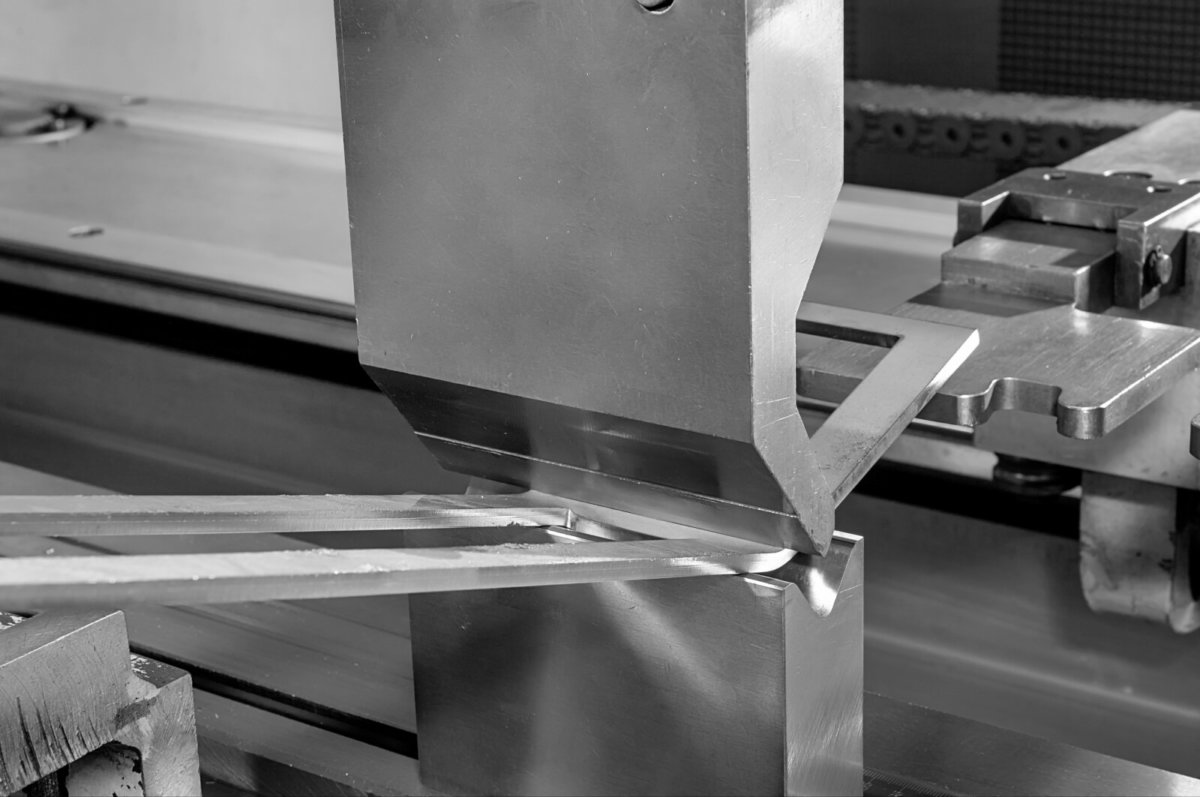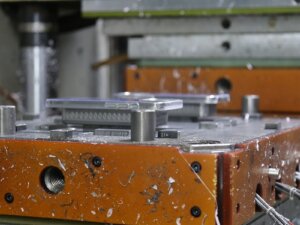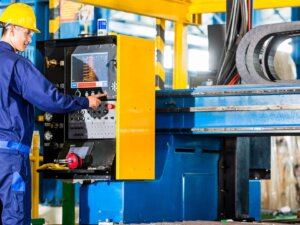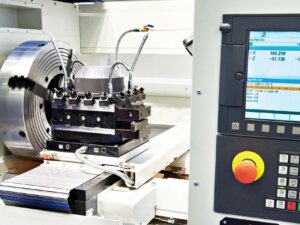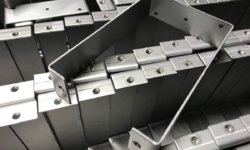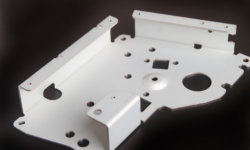Bending — sometimes called flanging or press braking — is one of the most important and widely used techniques in high-precision sheet metal fabrication .
Sheet metal bending allows manufacturers to turn a straight piece of sheet metal into an angled component, and this can be much more cost-effective than welding or affixing two separate pieces together.
The bending process typically works by using bending tools to apply force to the sheet metal in a way that causes permanent deformation. However, there are many different bending methods and pieces of bending machinery that can be used to achieve the best result. Complex bending calculations ensure that tight tolerances can be met.
This article serves as an introduction to sheet metal bending, looking at the basics of bending, typical bending equipment, types of sheet metal bending, and technical considerations like bending allowances and springback.
What is sheet metal bending?
Sheet metal bending is a metalworking technique used to turn flat pieces of sheet metal into V shapes, U shapes, or channel shapes.
It is an important and convenient manufacturing process, since bending a flat piece of sheet metal into a new shape is significantly cheaper than, for example, machining a V, U, or channel shape from a solid workpiece, or casting it in a foundry. Furthermore, bending produces a stronger part than, for example, welding two flat pieces of sheet metal together into a V shape.
Many types of sheet bending involve the use of a machine called a brake, sometimes called a bending machine or a sheet metal folder. Force can be applied manually or with, for example, hydraulics. A hydraulic press can exert high forces and can therefore bend greater sheet thicknesses.
Sheet metal bending equipment
The most important piece of sheet metal bending equipment is the brake, which comes in several distinct forms:
- A cornice brake is a simple bending machine — and the most widely used sheet metal brake in manufacturing — that clamps a piece of sheet metal to a flat surface, then, via movement of a moveable bending leaf, uses force to make straight bends or simple creases.
- A press brake is a bending machine that uses a moving punch and a corresponding die. During the bending operation, sheet metal is placed on the die and the punch is moved with force into the metal, forcing it into the die opening. Depending on the shape of the die, a press brake can be used to make V bends, U bends, and other shapes.
- A box-and-pan brake (also known as a finger brake) is another kind of sheet metal brake that uses a row of metal “fingers” to create multiple bend lines. As the name suggests, the box-and-pan brake is often used to make custom-size boxes.
- A bar folder is a small and simple bending machine with a single handle that clamps the sheet metal and bends it in a single motion.
Types of sheet metal bending
There are different varieties of bending used to achieve different bends in different ways. Three of these bending methods (air bending, bottoming, and coining) use a press brake, while the others use assorted machinery to create the desired bends.
Air bending
Air bending is a press brake bending method in which a punch forces sheet metal into a die but not so far that it touches the walls of the die.
This method is not as accurate as others, but it is highly flexible: it can be used to make V, U, and other shaped bends. This is partly because the die geometry does not need to correspond exactly to the desired sheet metal bend, since no contact is made between the two surfaces.
Bottoming
Bottoming is another press brake bending method. During the bottoming process, the punch forces the sheet metal fully into the die, creating a bend that corresponds to the geometry of the inside of the die. It used to make V-shaped bends.
Coining
Coining is a more expensive type of press brake bending in which a punch is lowered with much greater force at the sheet metal and into the die, creating a permanent deformation with very little springback. (Meaning the metal does not un-bend once the punch is withdrawn.)
Folding
Folding can be carried out on machines like a cornice brake or a bar folder. The sheet metal is clamped in place before a clamping beam rises to bend the metal around a profile. Folding achieves a V-shaped bend and allows positive or negative bend angles.
Wiping
Wiping (or edge bending or wipe bending) is another bending method suitable for machinery such as cornice brakes and bar folders (and in some cases press brakes). It is faster than folding but can inflict more damage to the surface of the sheet metal.
Roll bending
Roll bending is perhaps the most unique sheet metal forming process due to the machinery used. A roll bending system has three cylindrical rollers to bend sheet metal into an arc, and it is therefore useful for the fabrication of pipes, tubing, and other rounded parts.
Step bending
Step bending — sometimes called bump bending — is a way of approximating a smooth curved bend (such as that produced via roll bending) using a press brake. By performing several small V-shaped bends in succession, step bending can produce what looks like a curved bend.
Springback explained
When sheet metal is bent into a new shape, it naturally springs back to some extent after the bending force is removed. This is called “springback.”
Springback occurs due to the compressive strength of the bent sheet metal. When sheet metal is bent, one side of it is pulled and stretched, while the other side is compressed; however, since the material has higher compressive strength than tensile strength, the compressed side successfully resists the deformation and decompresses itself when the force is removed.
Springback is not a major problem, but it means manufacturers must compensate for the expected springback by over-bending the sheet metal. If the metal is intentionally slightly over-bent, a small degree of natural springback will result in the correct angle.
Of course, calculating springback is far from simple, and there are several variables that affect the severity of the springback, including the type and thickness of the material. Also, larger inside radii result in greater springback.
Calculations and allowances
When a piece of sheet metal gets bent, the side outside of the bend gets elongated, and its dimensions are therefore altered. This means that, for example, the total length of the two legs of a V-shaped bend will be longer than the original flat pattern.
So if the dimensions are altered, how do we accurately design a part, ensuring that it will fit together with other components? How do we decide how long the flat piece of sheet metal must be? To compensate for changes in dimensions, we must incorporate bend allowance: the difference between the length of the unfolded sheet and the sum of the lengths of each leg of the finished bent part.
Bend allowance calculations consider factors such as sheet metal thickness, bend radii, bend angles, and K-factor (ratio of neutral axis location to material thickness). The required bend allowance for a sheet metal part can be worked out using a bend allowance calculator.
Best sheet metal materials and gauges for bending
Some sheet metal materials are better for bending than others. Generally, the best bending materials are malleable and not brittle.
Popular materials for sheet metal bending include:
- Mild steel: Can be bent at any temperature.
- Spring steel: Bendable after annealing.
- Alloy steel 4140: Bendable after annealing.
- Aluminum 5052: Highly bendable compared to other aluminum alloys.
- Copper: Highly bendable.
Materials that are more difficult (though not impossible) to bend include aluminum 6061, carbon steel, titanium, brass, and bronze. Stainless steel can be bent, with the 300 series being more ductile than others.
Grain direction
The direction sheet metal grain — the direction in which the tiny crystals of the metal are elongated due to the original rolling of the sheet — affects how it bends.
Grain direction makes sheet metal stronger across one axis and weaker across the other. Bending with the grain (longitudinally) can increase the likelihood of cracking, tearing, or orange peeling; bending against the grain reduces the chances of these problems occurring.
But although bending against the grain reduces the odds of breakage, it also requires greater force, since the sheet metal is stronger. It may therefore result in more springback and require greater compensation in this regard.
3ERP is a sheet metal prototyping expert with years of experience bending materials. Contact us for a free quote on your next sheet metal project.
